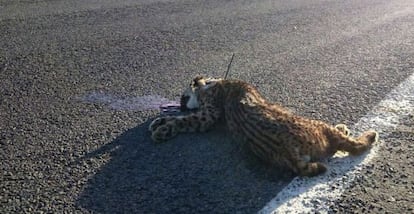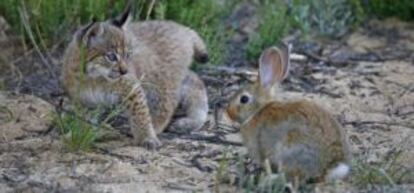Rise in Iberian lynx road deaths speeds up protection plans
Andalusia authorities to clear curbs and place new traffic signs to preserve the species


Andalusia’s population of endangered Iberian lynxes has quadrupled in the last three years, but the number of them killed on the region’s roads has grown by an even larger rate over the same period, environmentalists warn.
Getting struck by a moving vehicle continues to pose the greatest threat to the felines, whose main habitats are the Sierra Morena mountains and the Doñana National Park.
Of the 27 lynxes that died last year in the southern region, 21 were killed by motorists, according to the World Wildlife Fund (WWF).
This figure has triggered alarm bells in the regional government, which is speeding up work on an action plan to prevent further road deaths.
Both the Andalusian administration and the Spanish Public Works Ministry have agreed on a raft of urgent measures that include putting up more road signs alerting drivers to the presence of the animals, and reducing the speed limit in areas where the highest road-death rates have been recorded.
Authorities will also send crews out to examine the state of roadside fencing, to clean up the riverbeds to facilitate wildlife crossings, and to clear curbs of bushes to improve visibility.
“We need to find a solution to this serious problem, and contribute all available means,” admitted María Jesús Serrano, the Andalusian commissioner for public works and the environment.
Meanwhile, Environment Minister Isabel García Tejerina, of the center-right Popular Party (PP), put the record number of lynx deaths down to the fact that “the population has increased significantly” in recent years.
Although the action plan is national in scope, the main focus will be on Andalusia, where most of Spain’s remaining specimens live.

In September of last year the Andalusian government, which is ruled by the Socialist Party, earmarked €1 million for lynx safety improvements as part of the Life+Iberlince project. More recently, the southern region and Madrid discussed the possibility of applying for a new EU Life project to create an environmental corridor linking the northern portion of Doñana with Sierra Morena. The project would have an estimated budget of €4.25 million.
The lynx population in Andalusia rose from 92 specimens in 2002 to 332 individuals in 2014, expanding their presence in the area. “This, coupled with the new outbreak of rabbit haemorrhagic disease, makes many specimens venture near roads,” said an Environment Ministry source in reference to the epidemic killing the lynx’s main source of food.
One of the main goals of the Life+Iberlince project is to create new lynx populations in well-preserved parts of Portugal, and in the Spanish regions of Extremadura, Castilla-La Mancha, Murcia and Andalusia. The initiative also seeks to create connecting corridors between populations wherever possible.







































